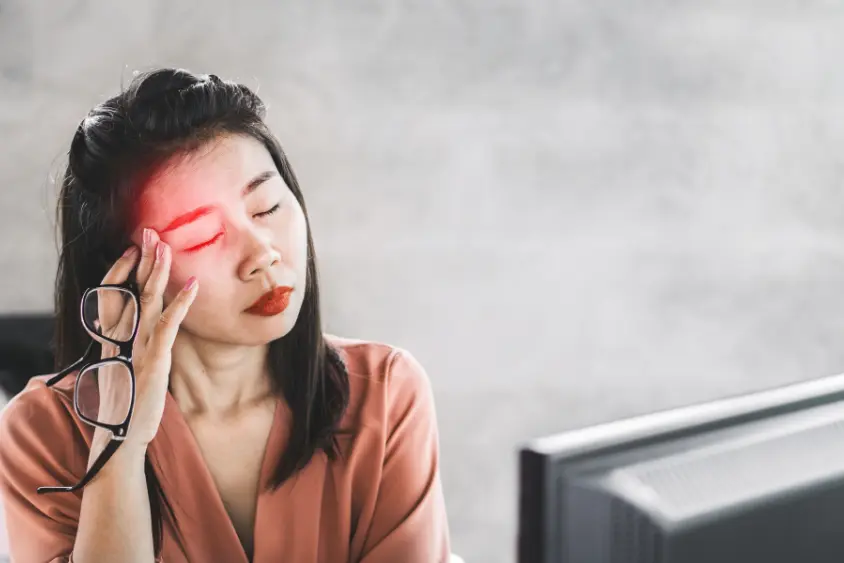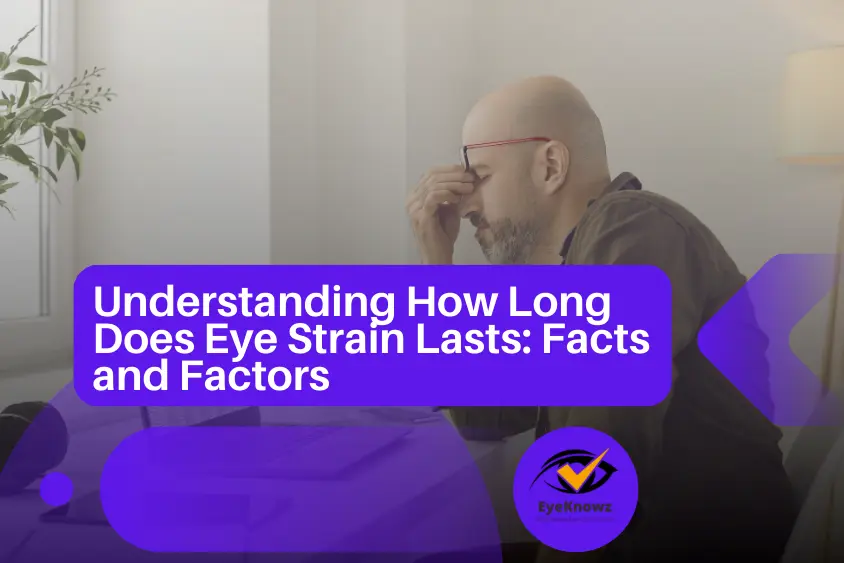How long does eye strain last? Discover the factors influencing eye strain duration, symptoms, and effective ways to alleviate discomfort.
You may be wondering how long it takes for your eyes to hurt after a long day on the computer. Could you relieve this discomfort so you can continue your day? Eye strain can occur from long-term use of technology, including prolonged screen time. Intensive use of your eyes causes the feeling. There may be some discomfort, but it is rarely severe. Various factors can cause eye strain, not just technology.
What is Eye Strain?
A condition known as eye strain causes your eyes to feel tired, dry, and uncomfortable. There are many reasons why this irritation can occur, from reading to using a computer. When you don’t take breaks, your eyes don’t get a chance to rest, which results in eye fatigue. Your eyes must continuously focus and refocus when using a computer or in another high-concentration activity, which can cause fatigue, especially if you don’t rest. Eye strain can occur from many activities, including reading, driving, and using technology.
What does eye strain feel like? It is uncomfortable and distracting to experience eye strain. Various factors can contribute to it, including sleep deprivation and poor vision. Eye strain can last longer than a short-term symptom. It can be difficult to relieve eye strain symptoms without knowing the cause. It may be a sign of more than tired eyes if you experience prolonged eye strain or new symptoms. It is therefore recommended that you consult your eye doctor whenever you notice changes in your vision or feel discomfort in your eyes.
How Long Does Eye Strain Last?
How long does it take for you to feel relief from eye strain? Symptoms of this condition typically last for a day, but it can have a negative impact on your quality of life. The effects of eye strain can vary from person to person, but they often go away after a person stops engaging in high-focus activities.
The duration of eye strain can vary from an hour to longer, depending on the severity. If accompanied by other symptoms, such as eye strain, headaches, or dry eyes, it may take longer to resolve.
What causes eye strain?

Why do my eyes feel strained? A person’s eyes can strain due to prolonged or unrestricted use of focusing muscles during activities that require more vision. Spending a lot of time on close-up activities every day is natural, but it can be quite uncomfortable for our eyes. Many eye problems and health factors can lead to eye strain, and there are many ways to prevent it. Identifying the cause can help you implement an appropriate treatment plan. Furthermore, it can assist you in determining how long your eye strain will last. Your activity can be altered or stopped if you know why it’s occurring. Eye strain is commonly caused by the following:
- Excessive exposure to blue light, usually generated by digital devices
- Screen lighting issues
- Maintain a close-up focus for a long time
- Seeing in dim light
- Fatigue or stress
- Dry eyes or vision problems
- High level of stress
- Sleep deprivation
Eye Strain Symptoms:
When you suffer from eye strain, you may experience the following symptoms:
- Double or blurry vision
- Eye fatigue
- Itchy eyes
- Watery eyes
- Dry eyes
- Headaches
- Back, neck, or shoulder pain
- Light sensitivity
- Having difficulty concentrating
- Twitching of the eyes
- Frequent squinting
Eye strain and vision problems:

Your eyes are unlikely to be permanently damaged by eye strain. The symptoms of eye strain can occur temporarily with a headache or sleep deprivation, or they may be long-term due to untreated vision problems. Eye strain that persists for hours or days, however, may indicate a variety of conditions:
- Astigmatism
- Dry Eye
- Hyperopia
- Myopia
- Presbyopia
When our eyes can’t focus light correctly, we have refractive errors. You may see more intense focus when your eyes compensate for the error. It is common for people who have refractive errors to experience eye strain.
Eye strain caused by refractive errors can quickly be relieved by wearing prescription lenses. The reversal of eye strain may not occur immediately. You may need to adjust for a short period of time. You can find out if you need prescription lenses with an eye exam. It is crucial to have prescription lenses for enhancing vision, reducing symptoms, and protecting your eye health.
Digital Eye Strain:
Excessive screen time can lead to digital eye strain, also known as computer vision syndrome (CVS). Long-term viewing of a digital screen can exhaust your vision system because your eyes are working harder. Digital eye strain symptoms may also be caused by untreated vision problems, especially refractive errors. The symptoms of digital eye strain include:
- Eye strain
- Dry eyes
- Headaches
- Blurry vision
- Having neck or shoulder pain
How to relieve eye strain?
Your poor eye health habits may be causing your eye strain, so it’s time to change. You should begin by noting activities or causes of your eye strain. When you know what, where, and why, you can take action to reduce symptoms. A change in your digital habits can help relieve or prevent irritation in the future. The following tips can help you prevent eye strain:
Apply the 20-20-20 rule:
In general, it is recommended to follow the 20-20-20 rule if you are using digital devices for multiple hours a day. Make sure you look at something at least 20 feet away for 20 seconds every 20 minutes. You can avoid overuse of your eyes by taking this break. Eye strain can be reduced by combining the 20-20-20 rule with additional solutions and helping you recover faster when it occurs.
Adjusting the screen:
Some adjustments can be made to reduce eye strain based on where your screen or device is located. It is ideal for your screen to be at eye level or slightly below eye level, at arm’s length from your eyes. Eye strain can be caused by glare and lighting, so adjusting the brightness and using a filter can help. Make your eyes feel special!
Optimizing the device:
Optimize all your devices (phone, laptop, etc.) to prevent discomfort. By matching the color and contrast of your devices, you will be able to see more clearly. Your devices may also allow you to increase the text size to make it easier to read.
Proper lighting:
Position your monitor away from windows and other bright light sources to avoid glare. Don’t let your room’s lights be too bright or dim — they should match the brightness of your screen. Thus, you can prevent straining your eyes to see clearly. You should also position your screen away from light sources such as direct sunlight and overhead lights.
Make use of eye drops:
A person blinks around 12 times per minute on average. It helps to lubricate the eyes by blinking. In contrast, staring at a computer screen or reading can significantly lower that number.
Less blinking can make your eyes feel dry and agitated. Blinking more often can give relief sometimes, but it is hard for most people to remember. Eye strain can be reduced by using eye drops or blinking frequently.
Maintain good eye health:
Visit your eye doctor regularly to ensure that your eyes remain healthy and limit the time that you spend using digital devices.
Final Thoughts:
You may experience eye strain due to reading, working on the computer, driving, or any other activity requiring extended eye use. An eye strain can be short-term or long-term. You need to find a solution if you feel uncomfortable or avoid activities due to symptoms. With lifestyle changes, you can prevent this annoying and uncomfortable problem. Screen time might not be the cause of persistent eye strain after all. Consult your eye doctor if you are uncertain how to treat your eye strain or think you may have underlying conditions.
FAQs:
How to fix eye strain?
To alleviate eye strain, there are several steps you can take. First, ensure proper lighting in the room, avoiding glare on screens. Take regular breaks when working on screens for extended periods. Adjust your screen’s brightness, contrast, and font size for comfort.
Why do my eyes feel strained?
There are various reasons your eyes might feel strained. One common cause is prolonged screen time, which causes digital eye strain by focusing on screens at a fixed distance. Poor lighting conditions, incorrect screen settings, uncorrected vision problems, and not taking frequent breaks can also contribute to eye strain. It’s essential to address these factors to prevent discomfort.
Can eye strain cause dizziness?
Yes, eye strain can sometimes lead to feelings of dizziness. Prolonged focus on screens or other tasks can result in overworked eye muscles. These strained muscles can transmit signals to the brain that might be interpreted as dizziness or imbalance.






